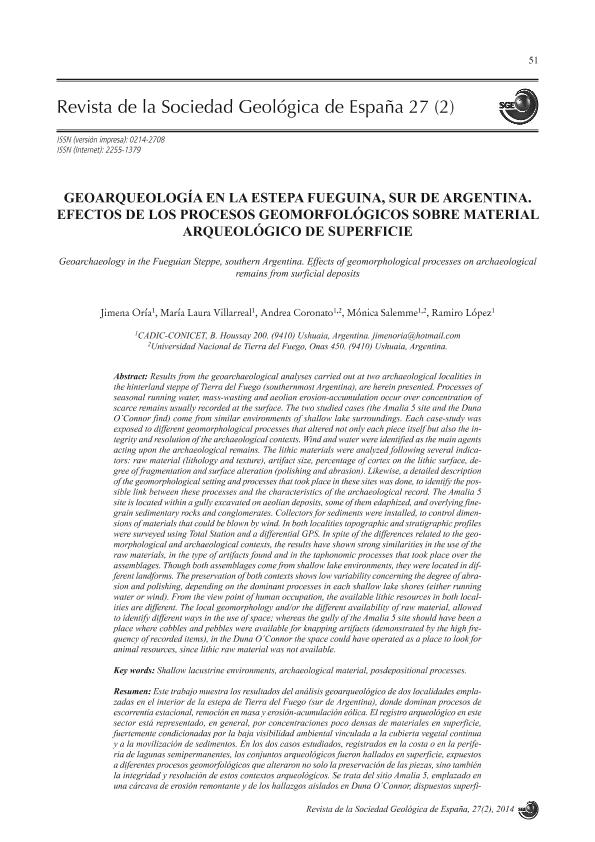Mostrar el registro sencillo del ítem
dc.contributor.author
Oria, Jimena

dc.contributor.author
Villarreal, María Laura

dc.contributor.author
Coronato, Andrea Maria Josefa

dc.contributor.author
Salemme, Monica Cira

dc.contributor.author
Lopez, Carlos Ramiro

dc.date.available
2016-05-09T19:14:38Z
dc.date.issued
2014-11
dc.identifier.citation
Oria, Jimena; Villarreal, María Laura; Coronato, Andrea Maria Josefa; Salemme, Monica Cira; Lopez, Carlos Ramiro; Geoarqueología en la estepa fueguina, Argentina. Efectos de los procesos geomorfológicos sobre material arqueológico de superficie; Sociedad Geológica de España; Revista de la Sociedad Española de Geología; 27; 2; 11-2014; 51-68
dc.identifier.issn
0214-2708
dc.identifier.uri
http://hdl.handle.net/11336/5582
dc.description.abstract
Results from the geoarchaeological analyses carried out at two archaeological localities in the hinterland steppe of Tierra del Fuego (southernmost Argentina), are herein presented. Processes of seasonal running water, mass-wasting and aeolian erosion-accumulation occur over concentration of scarce remains usually recorded at the surface. The two studied cases (the Amalia 5 site and the Duna O´Connor find) come from similar environments of shallow lake surroundings. Each case-study was exposed to different geomorphological processes that altered not only each piece itself but also the integrity and resolution of the archaeological contexts. Wind and water were identified as the main agents acting upon the archaeological remains. The lithic materials were analyzed following several indicators: raw material (lithology and texture), artifact size, percentage of cortex on the lithic surface, degree of fragmentation and surface alteration (polishing and abrasion). Likewise, a detailed description of the geomorphological setting and processes that took place in these sites was done, to identify the possible link between these processes and the characteristics of the archaeological record. The Amalia 5 site is located within a gully excavated on aeolian deposits, some of them edaphized, and overlying finegrain sedimentary rocks and conglomerates. Collectors for sediments were installed, to control dimensions of materials that could be blown by wind. In both localities topographic and stratigraphic profiles were surveyed using Total Station and a differential GPS. In spite of the differences related to the geomorphological and archaeological contexts, the results have shown strong similarities in the use of the raw materials, in the type of artifacts found and in the taphonomic processes that took place over the assemblages. Though both assemblages come from shallow lake environments, they were located in different landforms. The preservation of both contexts shows low variability concerning the degree of abrasion and polishing, depending on the dominant processes in each shallow lake shores (either running water or wind). From the view point of human occupation, the available lithic resources in both localities are different. The local geomorphology and/or the different availability of raw material, allowed to identify different ways in the use of space; whereas the gully of the Amalia 5 site should have been a place where cobbles and pebbles were available for knapping artifacts (demonstrated by the high frequency of recorded items), in the Duna O´Connor the space could have operated as a place to look for animal resources, since lithic raw material was not available.
dc.description.abstract
Este trabajo muestra los resultados del análisis geoarqueológico de dos localidades emplazadas en el interior de la estepa de Tierra del Fuego (sur de Argentina), donde dominan procesos de escorrentía estacional, remoción en masa y erosión-acumulación eólica. El registro arqueológico en este sector está representado, en general, por concentraciones poco densas de materiales en superficie, fuertemente condicionadas por la baja visibilidad ambiental vinculada a la cubierta vegetal continua y a la movilización de sedimentos. En los dos casos estudiados, registrados en la costa o en la periferia de lagunas semipermanentes, los conjuntos arqueológicos fueron hallados en superficie, expuestos a diferentes procesos geomorfológicos que alteraron no solo la preservación de las piezas, sino también la integridad y resolución de estos contextos arqueológicos. Se trata del sitio Amalia 5, emplazado en una cárcava de erosión remontante y de los hallazgos aislados en Duna O´Connor, dispuestos superficialmente entre sedimentos eólicos edafizados. Se presentan los conjuntos arqueológicos y se estudian indicadores que evidencian la alteración – tamaño, abrasión y pulido – de los materiales líticos. Asimismo, se describen detalladamente los emplazamientos geomorfológicos y los procesos actuantes en ambos casos con el fin de identificar la vinculación posible entre dichos procesos y las características del registro arqueológico.
dc.format
application/pdf
dc.language.iso
spa
dc.publisher
Sociedad Geológica de España
dc.rights
info:eu-repo/semantics/openAccess
dc.rights.uri
https://creativecommons.org/licenses/by-nc-sa/2.5/ar/
dc.subject
Ambiente Lacustre
dc.subject
Material Arqueológico
dc.subject
Procesos Geomorfológicos
dc.subject
Estepa Fueguina
dc.subject.classification
Geología

dc.subject.classification
Ciencias de la Tierra y relacionadas con el Medio Ambiente

dc.subject.classification
CIENCIAS NATURALES Y EXACTAS

dc.title
Geoarqueología en la estepa fueguina, Argentina. Efectos de los procesos geomorfológicos sobre material arqueológico de superficie
dc.title
Geoarchaeology in the Fueguian Steppe, southern Argentina. Effects of geomorphological processes on archaeological remains from surficial deposits
dc.type
info:eu-repo/semantics/article
dc.type
info:ar-repo/semantics/artículo
dc.type
info:eu-repo/semantics/publishedVersion
dc.date.updated
2016-04-01T17:26:49Z
dc.journal.volume
27
dc.journal.number
2
dc.journal.pagination
51-68
dc.journal.pais
España

dc.journal.ciudad
Madrid
dc.description.fil
Fil: Oria, Jimena. Consejo Nacional de Investigaciones Científicas y Técnicas. Centro Austral de Investigaciones Científicas; Argentina
dc.description.fil
Fil: Villarreal, María Laura. Consejo Nacional de Investigaciones Científicas y Técnicas. Centro Austral de Investigaciones Científicas; Argentina
dc.description.fil
Fil: Coronato, Andrea Maria Josefa. Consejo Nacional de Investigaciones Científicas y Técnicas. Centro Austral de Investigaciones Científicas; Argentina. Universidad Nacional de Tierra del Fuego; Argentina
dc.description.fil
Fil: Salemme, Monica Cira. Consejo Nacional de Investigaciones Científicas y Técnicas. Centro Austral de Investigaciones Científicas; Argentina. Universidad Nacional de Tierra del Fuego; Argentina
dc.description.fil
Fil: Lopez, Carlos Ramiro. Consejo Nacional de Investigaciones Científicas y Técnicas. Centro Austral de Investigaciones Científicas; Argentina
dc.journal.title
Revista de la Sociedad Española de Geología
dc.relation.alternativeid
info:eu-repo/semantics/altIdentifier/url/http://www.sociedadgeologica.es/archivos/REV/27(2)/art06_2702.pdf
Archivos asociados
